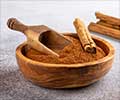Sarath Kumara, whose cinnamon plantation in Sri Lanka was devastated during the Asian tsunami, was forced to start over with nothing. But the farmer faces a new threat from further afield.

But the industry says its product known the world over as "Ceylon cinnamon" is being undermined by a cheaper rival called "cassia cinnamon" grown mostly in China, Southeast Asia and neighbouring India.
"It took about four years before I could get any crops from new trees and it is only now they are giving a full yield," Kumara, 54, said at his ancestral farm in Hikkaduwa, 100 kilometres (60 miles) south of Colombo.
"I have not seen cassia, but we know that some people (abroad) adulterate our cinnamon with cassia or sell cassia as Ceylon cinnamon."
Kumara lost a brother and a sister-in-law, while half of his 9,000 trees were uprooted, when walls of water destroyed plantations in the 2004 Boxing Day tsunami and left 31,000 people dead and a million homeless across the country.
The industry eventually recovered to become stronger than ever thanks to international donors and a herculean effort by its farmers who replanted half a million cinnamon trees in Hikkaduwa, and adjoining Balapitiya area.
Advertisement
The Spice Council of Sri Lanka wants to protect the brand "Ceylon cinnamon" and has approached the World Trade Organization and the European Union about gaining copyright or a patent.
The council wants the WTO to declare "Ceylon cinnamon" a specific product based on a "geographical indication" along the same lines as Champagne which comes from the region with the same name in northern France.
Under Portuguese, Dutch and finally British colonial rule from the 1500s, the Indian Ocean island was called Ceylon and switched to Sri Lanka upon becoming a republic in 1972.
The aromatic spice -- used in savoury dishes and desserts -- grew naturally in Sri Lanka for centuries before Dutch invaders started commercial crops in the 17th century.
- Tsunami forces upgrade -
Sri Lanka's industry, which supplies 80 percent of the world market, is enjoying record export earnings for the island. High-grade cinnamon oil, extracted from the bark, has been fetching up to 65,000 rupees ($510) a kilogram.
Cinnamon earned Sri Lanka a record $135 million from 13,866 tonnes exported last year compared to $47 million from 12,000 tonnes in 2005 -- with Mexico, Colombia, Peru and the US the major buyers.
"Prices have never been so good," de Silva said. "The challenge is to get our geographical indication recognised (by the WTO and others) That is the best way to deal with cassia."
The tsunami tragedy pushed devastated cinnamon farmers to invest in better technology upon rebuilding their farms and oil mills, and are now reaping the rewards.
"After replanting, it took me four years to make money again," farmer Upul Asanka, who lost his farm in the tsunami, said. "Initially there was salinity in the soil, but it is better now," the 38-year-old said.
Kumara said he harvests his 9,000 trees every eight months, compared to every 18 months before the tragedy. "Since the tsunami our agricultural practice has improved," Kumara said. "I notice that the replanted trees give a better crop," he added.
Improved productivity has also allowed farmers to produce more of the lower-grade oil extracted from cinnamon tree leaves for use in balms, disinfectants, detergents and soap. The more expensive bark oil, meanwhile, is being sold for addition to high-end perfumes and even fizzy drinks.
The council has commissioned a study into the perceived health effects of cinnamon which some have long claimed lowers blood sugar levels and cholesterol.
Chef Dell'Ascenza Riccardo of Sri Lanka's biggest luxury hotel chain, also known as "Cinnamon", said he has started using the famed local product in his Italian dishes.
"I use it for my red wine sauce and many other dishes," Riccardo told AFP. "The diners feel something different and it makes a good impression."
Source-AFP













